- 著者
- Yoshimichi Sato Ryuta Saito Masayuki Kanamori Teiji Tominaga
- 出版者
- The Japan Neurosurgical Society
- 雑誌
- NMC Case Report Journal (ISSN:21884226)
- 巻号頁・発行日
- vol.7, no.1, pp.39-41, 2020 (Released:2020-01-01)
- 参考文献数
- 7
- 被引用文献数
- 3
Cystic tumors, such as craniopharyngiomas and Rathke’s cleft cysts, as well as arachnoid cysts have been reported to rupture occasionally. Approximately 8–10% of glioblastomas (GBMs) are known to have a significant cystic component; however, to the best of our knowledge, no studies have reported cystic rupturing of GBMs. Here, we describe a unique case of cystic GBM rupturing and penetrating into the cerebral ventricle. A 77-year-old man with a right frontal lobe lesion suspected as GBM with a large cyst was referred to our hospital. At admission, disorientation and left facial weakness were detected. Consciousness disturbance worsened on the 8th day of hospitalization. Computed tomography (CT) revealed prominent shrinkage of the tumor and intratumoral cyst. Signs of meningeal irritation were observed, and chemical meningitis due to cystic tumor rupture and leakage of necrotic components into the ventricle was highly suspected. Surgical resection of the right frontal lobe tumor was performed on the 10th day of hospitalization. During the surgery, clear and colorless cerebrospinal fluid was obtained upon penetration of the tumoral cyst, suggesting traffic of tumor cysts and cerebral ventricle. Adjuvant chemoradiation therapy was initiated postoperatively. Local recurrence was noted at the corpus callosum 7 months postoperatively and was treated with a gamma knife. Further therapy was performed after this recurrence. However, his condition gradually deteriorated 15 months postoperatively, and he was subjected to terminal care. To the best of our knowledge, this is the first report on a cystic GBM rupture.
- 著者
- Arata NAGAI Yasuhiro SUZUKI Tomohisa ISHIDA Yoshimichi SATO Tomoo INOUE Teiji TOMINAGA
- 出版者
- The Japan Neurosurgical Society
- 雑誌
- Neurologia medico-chirurgica (ISSN:04708105)
- 巻号頁・発行日
- pp.2022-0155, (Released:2022-10-13)
- 参考文献数
- 31
- 被引用文献数
- 1
Delayed cerebral vasospasms after subarachnoid hemorrhage (SAH) are a risk factor for poor prognosis after successful treatment of ruptured intracranial aneurysms. Different strategies to remove clots from the subarachnoid space and prevent vasospasms have different outcomes. Intrathecal urokinase infusion therapy combined with endovascular treatment (EVT) can reduce the incidence of symptomatic vasospasms. To analyze the relationship between symptomatic vasospasms and residual SAHs after urokinase infusion therapy, we retrospectively reviewed the records of 348 consecutive patients managed with EVT and intrathecal urokinase infusion therapy for aneurysmal SAH at our institution between 2010 and 2021. Among them, 163 patients met the study criteria and were classified into two groups according to the presence of residual SAH in the cisterns, Sylvian fissures, and frontal interhemispheric fissure. The incidence of symptomatic vasospasms and the clinical outcomes were assessed. In total, eight (5.0%) patients developed symptomatic vasospasms. Patients with symptomatic vasospasms had a significantly higher incidence of residual SAH in the Sylvian or frontal interhemispheric fissures than those without (P <.0001). No patient with SAHs resolved by urokinase infusion therapy developed symptomatic vasospasms. However, the two groups did not differ significantly in terms of modified Rankin scale scores at discharge. Treatment with intrathecal urokinase infusion after EVT for aneurysmal SAH can substantially reduce the risk of clinically evident vasospasms.
- 著者
- Yoshimichi SATO
- 出版者
- 数理社会学会
- 雑誌
- 理論と方法 (ISSN:09131442)
- 巻号頁・発行日
- vol.18, no.2, pp.185-196, 2003-09-30 (Released:2009-01-20)
- 参考文献数
- 15
- 被引用文献数
- 2
Although evolutionary game theory has been popular in social sciences, we have seldom checked its utility as a tool in sociology. In this paper I argue that evolutionary game theory is a good tool with which we study evolution of certain types of social order, but that it has a limitation when we apply it to the study of evolution of the division of labor. To prove the argument, I first adopt a working definition of social order as a self-enforcing relationship between action and expectation. Then I adopt the fictitious play and best reply assumptions rather than the hardwired strategy and replicator dynamics assumptions, because the former are fitter for analysis of the self-enforcing relationship. Third, I claim that the core of the division of labor is the creation of new roles and build an evolutionary game theoretic framework of evolution of the division of labor. Finally, I point out that a limitation of evolutionary game theory in the study of evolution of the division of labor as social order is that it assumes a finite set of possible actions, while evolution of the division of labor accompanies new actions. This limitation, however, shows us where to attack to make a breakthrough.
